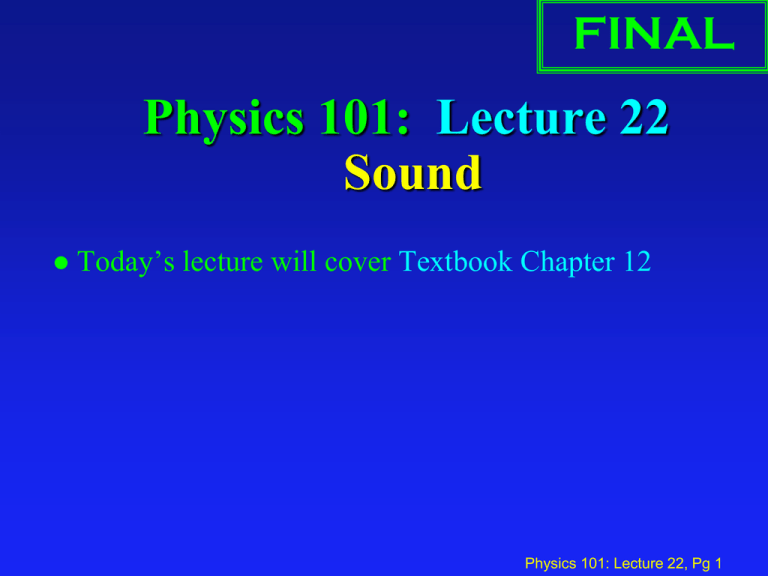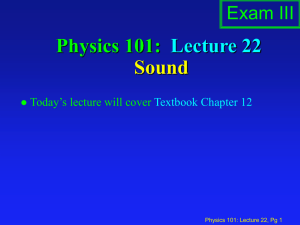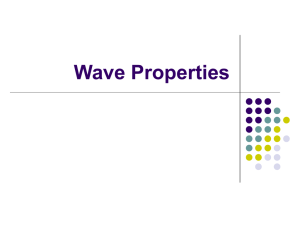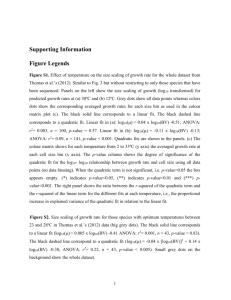Physics 101: Lecture 22 Sound
advertisement

FINAL Physics 101: Lecture 22 Sound Today’s lecture will cover Textbook Chapter 12 Physics 101: Lecture 22, Pg 1 Speed of Sound for pulse on string: v = sqrt(T / m) For fluids: v = sqrt(B/r) Recall Medium Speed (m/s) Air 343 Helium 972 Water 1500 Steel 5600 Physics 101: Lecture 22, Pg 2 05 Velocity ACT A sound wave having frequency f0, speed v0 and wavelength l0, is traveling through air when in encounters a large helium-filled balloon. Inside the balloon the frequency of the wave is f1, its speed is v1, and its wavelength is l1 Compare the speed of the sound wave inside and outside the balloon 1. v1 < v0 2. v1 = v0 3. v1 > v0 correct V0=343m/s V1=965m/s Physics 101: Lecture 22, Pg 3 10 Frequency ACT A sound wave having frequency f0, speed v0 and wavelength l0, is traveling through air when in encounters a large helium-filled balloon. Inside the balloon the frequency of the wave is f1, its speed is v1, and its wavelength is l1 Compare the frequency of the sound wave inside and outside the balloon 1. f1 < f0 2. f1 = f0 correct 3. f1 > f0 f0 f1 Time between wave peaks does not change! Physics 101: Lecture 22, Pg 4 13 Wavelength ACT A sound wave having frequency f0, speed v0 and wavelength l0, is traveling through air when in encounters a large helium-filled balloon. Inside the balloon the frequency of the wave is f1, its speed is v1, and its wavelength is l1 Compare the wavelength of the sound wave inside and outside the balloon 1. l1 < l0 2. l1 = l0 l1 l0 correct 3. l1 > l0 l=v/f Physics 101: Lecture 22, Pg 5 15 Intensity and Loudness Intensity is the power per unit area. I = P / A Units: Watts/m2 For Sound Waves I = p02 / (2 r v) (po is the pressure amplitude) Proportional to p02 Loudness (note: Energy goes as A2) (Decibels) Loudness perception is logarithmic Threshold for hearing I0 = 10-12 W/m2 b = (10 dB) log10 ( I / I0) b2 – b1 = (10 dB) log10(I2/I1) Physics 101: Lecture 22, Pg 6 18 Log10 Review Log10(1) =0 Log10(10) = 1 Log 10(100) = 2 Log10(1,000) = 3 Log10(10,000,000,000) Are you going to have lots of loud, banging demos now that we're studying sound? = 10 Physics 101: Lecture 22, Pg 7 19 Decibels ACT If 1 person can shout with loudness 50 dB. How loud will it be when 100 people shout? 1) 52 dB 2) 70 dB 3) 150 dB b100 – b1 = (10 dB) log10(I100/I1) b100 = 50 + (10 dB) log10(100/1) b100 = 50 + 20 Physics 101: Lecture 22, Pg 8 22 Amazing Ear Your Ear is sensitive to an amazing range! 1dB – 100 dB 10-12 Watts/m2 1 Watt/m2 Like a laptop that can run using all power of Battery Entire Nuclear Power Plant Physics 101: Lecture 22, Pg 9 23 Intensity ACT Recall Intensity = P/A. If you are standing 6 meters from a speaker, and you walk towards it until you are 3 meters away, by what factor has the intensity of the sound increased? 1) 2 2) 4 3) 8 Speaker radiating power P I1 = P/(4pD12) D1 Area goes as d2 so if you are ½ the distance the intensity will increase by a factor of 4 I2 = P/(4pD22) D2 Physics 101: Lecture 22, Pg 10 27 Standing Waves in Pipes Open at both ends: Pressure Node at end l = 2 L / n n=1,2,3.. Open at one end: Pressure AntiNode at closed end :l = 4 L / n n odd Physics 101: Lecture 22, Pg 11 Organ Pipe Example A 0.9 m organ pipe (open at both ends) is measured to have it’s first harmonic at a frequency of 382 Hz. What is the speed of sound in the pipe? Pressure Node at each end. l = 2 L / n n=1,2,3.. l = L for first harmonic (n=2) f=v/l v = f l = (382 s-1 ) (0.9 m) = 343 m/s Physics 101: Lecture 22, Pg 12 32 Resonance ACT What happens to the fundamental frequency of a pipe, if the air (v=343 m/s) is replaced by helium (v=972 m/s)? 1) Increases 2) Same 3) Decreases f = v/l Physics 101: Lecture 22, Pg 13 34 Preflight 1 As a police car passes you with its siren on, the frequency of the sound you hear from its siren Doppler Example Audio Doppler Example Visual 1) Increases 34% 61% 5% 0% 20% 40% 60% 80% 2) Decreases 3) Same I drew on life experience for this question. Based on the many close calls I have had with fuzz, I know the sound described sounds like the following: WEEEEOOOOOAAAAH!!!! Notice that the pitch begins high with a "WEEE" sound and then quickly decreases to "OOAAA!!". Pitch, I believe corresponds with frequency: high pitch=high frequency, low pitch=lower frequency. Physics 101: Lecture 22, Pg 14 36 Doppler Effect moving source vs When source is coming toward you (vs > 0) Distance between waves decreases Frequency increases When source is going away from you (vs < 0) Distance between waves increases Frequency decreases fo = fs / (1- vs/v) Physics 101: Lecture 22, Pg 15 38 Doppler Effect moving observer (vo) When moving toward source (vo < 0) Time between waves peaks decreases Frequency increases When away from source (vo > 0) Time between waves peaks increases Frequency decreases fo = fs (1- vo/v) Combine: fo = fs (1-vo/v) / (1-vs/v) Physics 101: Lecture 22, Pg 16 40 Doppler ACT A: You are driving along the highway at 65 mph, and behind you a police car, also traveling at 65 mph, has its siren turned on. B: You and the police car have both pulled over to the side of the road, but the siren is still turned on. In which case does the frequency of the siren seem higher to you? f f’ A. Case A v B. Case B correct C. same vs vo 65 mph vo 1 1 f' v v f 1 vs 65 mph 1 1 v v Physics 101: Lecture 22, Pg 17 44 Interference and Superposition Constructive interference Destructive interference Physics 101: Lecture 22, Pg 18 45 Superposition & Interference Consider two harmonic waves A and B meeting at x=0. Same amplitudes, but 2 = 1.15 x 1. The displacement versus time for each is shown below: A(1t) B(2t) What does C(t) = A(t) + B(t) look like?? Physics 101: Lecture 22, Pg 19 46 Superposition & Interference Consider two harmonic waves A and B meeting at x=0. Same amplitudes, but 2 = 1.15 x 1. The displacement versus time for each is shown below: A(1t) B(2t) C(t) = A(t) + B(t) DESTRUCTIVE INTERFERENCE CONSTRUCTIVE INTERFERENCE Physics 101: Lecture 22, Pg 20 47 Beats Can we predict this pattern mathematically? Of course! Just add two cosines and remember the identity: A cos( 1t ) A cos( 2 t ) 2 A cos L t cos H t where L 1 1 2 2 and H 1 1 2 2 cos(Lt) Physics 101: Lecture 22, Pg 21 49 Summary Speed of sound v = sqrt(B/r) Intensity b = (10 dB) log10 ( I / I0) Standing Waves fn = n v/(2L) fn = n v/(4L) Open at both ends n=1,2,3… Open at one end n=1,3,5… Doppler Effect fo = fs (v-vo) / (v-vs) Beats L 1 1 2 2 Physics 101: Lecture 22, Pg 22 50










